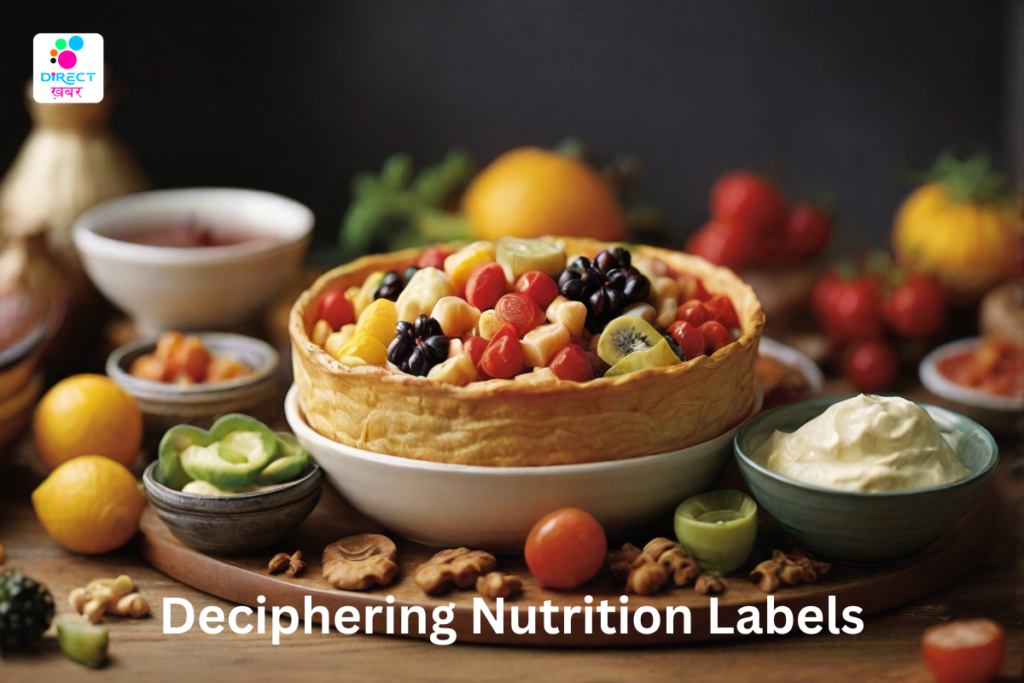Deciphering Nutrition Labels
Nutrition labels provide valuable information about the nutritional content of packaged foods, empowering consumers to make informed choices about their diets. Understanding how to interpret these labels is essential for maintaining a healthy lifestyle. In this guide, we’ll explore the components of nutrition labels and provide practical tips for navigating them effectively.

Components of Nutrition Labels:
a. Serving Size:
- The serving size indicates the amount of food typically consumed at one time and serves as the basis for all other nutritional information on the label. Pay attention to the serving size to accurately assess the nutritional content of the food you’re consuming.
- Calories represent the amount of energy provided by one serving of the food.Be mindful of calorie intake, especially if you’re trying to manage your weight or adhere to a specific calorie goal.
i. Fat:
– Total Fat: This includes both saturated and unsaturated fats.
– Saturated Fat: Limit intake of saturated fats, which can increase cholesterol levels and risk of heart disease.
– Trans Fat: Avoid trans fats, as they are associated with adverse health effects.
ii. Carbohydrates:
– Total Carbohydrates: This includes sugars, dietary fiber, and other carbohydrates.
– Sugars: Be cautious of added sugars, which contribute to excess calorie intake and can negatively impact health.
– Fiber: Aim for foods high in dietary fiber, as it supports digestive health and helps control blood sugar levels.
iii. Protein:
– Protein is essential for building and repairing tissues in the body.
– Choose foods rich in protein to support muscle health and satiety. d. Vitamins and Minerals:
- Nutrition labels often list the percentage of daily values (%DV) for various vitamins and minerals.
- Use this information to assess the nutritional quality of the food and ensure you’re meeting your daily nutrient requirements.

Understanding Percent Daily Values (%DV):
- %DV indicates how much a nutrient in one serving of the food contributes to your daily recommended intake.
- Aim for foods with higher %DV of nutrients such as fiber, vitamins, and minerals, while limiting those high in saturated fat, sodium, and added sugars.
Ingredients List:
- The ingredients list provides insight into the composition of the food product.
- Ingredients are listed in descending order by weight, with the primary ingredient listed first.
- Avoid foods with lengthy ingredient lists containing additives, preservatives, and artificial sweeteners.
Tips for Making Informed Food Choices: a. Compare Labels:
- When shopping for similar products, compare nutrition labels to choose the option that aligns with your dietary goals.
b. Prioritize Nutrient-Dense Foods: - Opt for foods rich in nutrients like vitamins, minerals, and fiber, while limiting those high in unhealthy fats, sugars, and sodium.
c. Be Mindful of Portion Sizes: - Pay attention to serving sizes to avoid overeating and accurately assess the nutritional content of foods.
d. Consider Your Dietary Needs: - Take into account any dietary restrictions or preferences, such as gluten-free, vegetarian, or low-sodium diets, when selecting foods.
e. Aim for Balance: - Strive for a balanced diet that includes a variety of nutrient-rich foods from all food groups.
Nutrition labels serve as valuable tools for making informed food choices that support health and well-being. By understanding the components of nutrition labels and applying practical tips for interpretation, consumers can navigate the grocery aisle with confidence, selecting foods that align with their nutritional goals and preferences. Empower yourself with knowledge and take control of your diet by utilizing the information provided on nutrition labels to make healthier choices for you and your family.
The impact of informed food choices extends far beyond individual health; it ripples through families, communities, and society at large. By making conscious decisions about the foods they purchase and consume, individuals not only enhance their own well-being but also contribute to broader efforts to combat diet-related health issues and promote nutritional literacy. As agents of change in their own lives and beyond, consumers wield the power to shape a healthier future for themselves and future generations.






